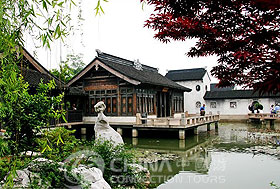Jiangsu province lies in the center of China's east coast. It occupies the southern part of the North China plain and the plains of the lower reaches of the Yangtze River. The province has many rivers and lakes, among which are the third biggest freshwater lake, Taihu Lake, and the fourth biggest, Hongze Lake. It has a 1000 kilometer long coast line. Shanghai, the largest city in China, borders it. The provincial capital is Nanjing.
Jiangsu Province is situated in the temperate subtropical zone, with a humid and semi-humid monsoon climate. The annual average temperature is 13C-16C (58-60F) in January, and 26C-29C (80-86F) in July. The Nanjing area is one of the three "furnaces" in the Yangtze River basin. The annual average precipitation is about 800-1200 millimeters. Most of the rain falls when spring is changing into summer when the plums are ripening. It rains for short frequent periods. It is a common phenomenon to see rain falling while the sun is shining. Rains of this period are called "plum rains." Because of the damp climate and hot temperature, mould grows quickly, so this period is also called "mould rains." Typhoons often hit this province at the end of summer and the beginning of autumn
Human beings were living in the Nanjing area more than 100 thousand years ago. Primitive villages appeared in Nanjing and near Taihu Lake over 6000 years ago and the inhabitants began primitive agriculture production. The smelting and forging of bronze wares in Jiangsu 3000 years ago reached a high technological level. In the 3rd to the 6th centuries A.D., Nanjing became the economic and cultural center of south China. In the 7th to the 10th centuries, China's economic center moved southward. In the 14th to the mid 17th centuries, Suzhou, Songjiang and Nanjing became the cradle of capitalism in China. In the later 19th century, industries such as textiles, and coal kept the province economically ahead of the rest of China.
With a population of about 74.38 million people and an average of 725 residents per square kilometer, Jiangsu province is the most densely populated area in China.
 Jiangsu has been a tourist paradise since ancient times. Nanjing, Suzhou, Yangzhou, Zhenjiang, Changshu, Xuzhou and Huai'an are famous historical and cultural cities. Sixteen cities, in the province have been labeled "fine tourist cities" in the country, including Nanjing, the capital of six dynasties, and Suzhou, the Paradise on Earth. There are three major tourist centers in Jiangsu, the Yangtze River area, the Tai Lake area and the Xuhuai (Xuzhou and Huai'an) area. There are 20 well-known scenic spots, 23 forest parks, 6 tourism and holiday resorts and 461 historical sites under state and provincial protection. Nine classical gardens in Suzhou are designated by UNESCO as World Cultural Heritage sites.
Jiangsu has been a tourist paradise since ancient times. Nanjing, Suzhou, Yangzhou, Zhenjiang, Changshu, Xuzhou and Huai'an are famous historical and cultural cities. Sixteen cities, in the province have been labeled "fine tourist cities" in the country, including Nanjing, the capital of six dynasties, and Suzhou, the Paradise on Earth. There are three major tourist centers in Jiangsu, the Yangtze River area, the Tai Lake area and the Xuhuai (Xuzhou and Huai'an) area. There are 20 well-known scenic spots, 23 forest parks, 6 tourism and holiday resorts and 461 historical sites under state and provincial protection. Nine classical gardens in Suzhou are designated by UNESCO as World Cultural Heritage sites.

